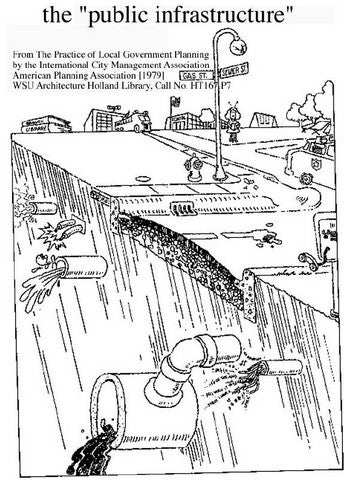Infrastructure? In a word, no!

Mar. 03
By Thomas J. Walsh
For PlanPhilly
The upcoming conference of the American Planning Association, scheduled for April 25-29 in Minneapolis, does not appear to have any sessions on what can sometimes be the arroyo-dry language of planning, development and real estate.
The big one that needs an overhaul? It’s “infrastructure.” That now-ubiquitous word’s tongue-flummoxing consonants, visually bracketing vowels and tonally downward cadence is yawn-inducing and eye-averting. Not that it’s a very good barometer (of anything), but has there ever been even one text message sent that included the word? (And if so, how was it condensed? Nfrcstre? Infrstrctr? N-fruc?) Most people would be loathe to put “infrastructure” even in an email.
“Bones” is gaining in use, PlanPhilly has noticed, as in, “At least the city has good bones to get things started.” Unfortunately, a variant is “bone-dry.”
The basic synonyms – framework, roots, base, footing, groundwork, support – don’t seem to work. We need something else. The underpinnings (also a synonym) of the word are so complex that the Clinton Administration, in 1996, was compelled to write an executive order about it. The order states that the functions of “certain national infrastructures are so vital that their incapacity or destruction would have a debilitating impact on the defense or economic security of the United States.”
The order then officially classifies eight “critical infrastructures:” telecommunications, electrical power systems, gas and oil storage and transportation, banking and finance, transportation, water supply systems, emergency services and continuity of government. (Interesting that “gas and oil storage and transportation” is distinct from mere “transportation. The Internet might be a ninth, separate from telecomm.)
Pluralizing the word seems to diminish it somewhat – to positive effect in this case. The eight official categories, individually, seem too important to be sub-anything.
Still, language matters, and it looks like we’re stuck with a clunker. Felix Rohatyn, a former banker and the author of the new book, “Bold Endeavors: How Our Government Built America and Why It Must Rebuild Now,” said in a Feb. 8, 2009 interview in the New York Times Magazine that “infrastructure” is a “terrible word.” Nevertheless, he was due to address the National Governors Association conference that weekend in Washingtion, D.C., about the need for a “national infrastructure bank.”
(After President Obama’s recent stimulus bill was approved, including $120 billion for infrastructure, about twice what he said was needed during the campaign, the national infrastructure bank he had called for was not part of the deal.)
Rohatyn, 80, spent his childhood in France and his family barely escaped the Nazis. Interviewer Deborah Solomon commented, “I wonder if your passion for infrastructure is rooted in a fear that everything around you is about to collapse.” Rohatyn: “That’s possible.” Solomon: “It’s unusual to write a book on infrastructure if you’re not an engineer.” Rohatyn: “Unless your objective is to bore people to death.”
Let’s hope he took a lesson from the kind of prose that came out of the urban renewal debates of the 1950s and ’60s. Alexander B. Callow, Jr. introduced his 1969 compendium, “American Urban History,” by quoting O. Henry: “… A ragged purple dream, the wonderful, cruel, enchanting, bewildering, fatal, great city.”
A page later, Callow described a group of urban historians that stressed “the importance of the city as a singularly important phenomenon in itself,” was also a group that believed a city has “a coherence, unity, muscles, and sinews of its own.”
“Muscles and sinews” beat “bones” hands-down. Ed Bacon, in his foreword to “Design of Cities,” wrote of the “muscular and sensory images” on which his work was based in the very first sentence of the classic text. He wanted his version of the “series of creative forces” that took place during his tenure as Philadelphia’s chief planner to be available any place in the world “where there is a desire for a finer physical expression of man’s inner aspirations.”
Well into the last decade of his time with us, Bacon was constantly flexing his arms to make a point, standing suddenly or twisting his torso away when he heard what he considered gibberish from an interviewer. He thought nothing of a river-to-river gambol in his late ’80s. Slamming a fist into a hand to drive home a point was common.
A tenet of the copy editor is never to use two words when one will do. But one could argue that “movement systems,” which seems to be Bacon’s preferred term for “transportation,” is more accurate, and more applicable as we break down those systems into the very different issues surrounding highways, railroads, light rail and airports.
How about we rescue a word from the fictional clutches of post-apocalyptic poster boy Keanu Reeves and start using “matrix” instead?
Not to dumb it down. But another rule from the copy desk is to eschew obfuscation. (Sorry – an old editor joke there for “keep it simple.”) Though we’re a little tongue-in-cheek here, the term “infrastructure” keeps, well, sprawling, and well beyond urban versus suburban.
There’s traditional utilities and the hope for a green infrastructure. Electronic infrastructure and the Internet. The whole broadband spectrum, perhaps. Does the cell phone network constitute its own infrastructure? How about global positioning systems, or other satellite-based networks? Oh, and health care. (For an eye-opening illustration of the variants of the concept, click on the link to the appropriations side of the Federal stimulus package, below, where the word is used almost 50 times over 496 pages. The link is to a pdf of the final bill.)
Bacon, fond of the term “built environment,” might have approved of “matrix.” Fascinated by physics and micro-scientific discoveries such as DNA, Bacon formulated diagrams that would include the mixing of, say, the behavioral sciences with construction technology, among others. Combine his circular “Idea / Action” social synthesis plane (characteristically, he once called it “my E=mc2”) with the eye-like drawing that commences the chapter on self-perception, and you have definite matrix-like thoughts.
Looking back at the classic city planning literature, you won’t find “infrastructure” in the tables of contents or the indexes of Bacon’s or Callow’s books. Nor Jane Jacobs’ “The Death and Life of American Cities,” or Robert Caro’s “The Power Broker.” But it’s throughout some of the more modern stuff, and perhaps necessarily so, as aging public works begin to die.
In “Century of the City; No Time to Lose,” by Neil Peirce and Curtis Johnson and published just last year, the word is mentioned at least a dozen times, including a section on privatization, described as “the ‘hot’ new infrastructure idea of recent years,” and the possibility of public-private partnerships.
Of course, when Peirce and Johnson’s book went to press, the country still had entities called “investment banks,” and there was no call for any kind of national infrastructure bank.
Suggestions for synonyms, or even a wholly new word, are welcome. There might be a falafel in it for you, amid the street-vendor infrastructure woven throughout Penn’s campus.
Contact the reporter at thomaswalsh1@gmail.com.
ON THE WEB:
Stimulus package infrastructure breakdown (New York Times): http://projects.nytimes.com/44th_president/stimulus/infrastructure
Federal economic stimulus plan (appropriations): http://www.house.gov/billtext/hr1_legtext_cr.pdf
Felix Rohatyn interview: http://www.nytimes.com/2009/02/08/magazine/08wwln-Q4-t.html?scp=3&sq=rohatyn&st=cse
Urban Land Institute summary press release, “Infrastructure 2008: A Competitive Advantage:” http://commerce.uli.org/AM/Template.cfm?Section=Home&CONTENTID=125957&TEMPLATE=/CM/ContentDisplay.cfm
Wikipedia entry: http://en.wikipedia.org/wiki/Infrastructure
WHYY is your source for fact-based, in-depth journalism and information. As a nonprofit organization, we rely on financial support from readers like you. Please give today.






